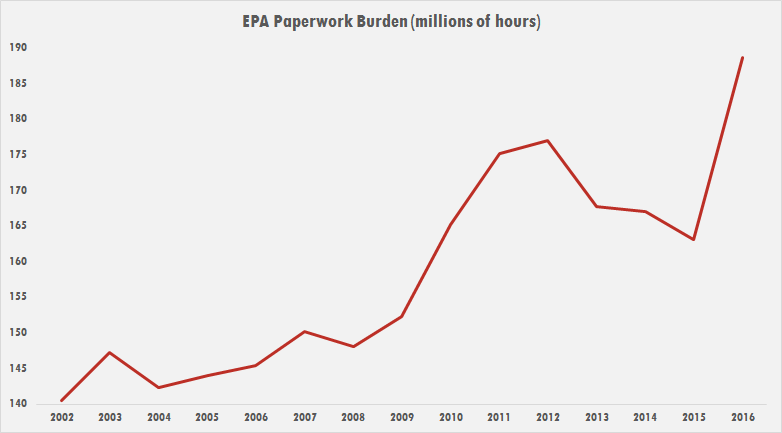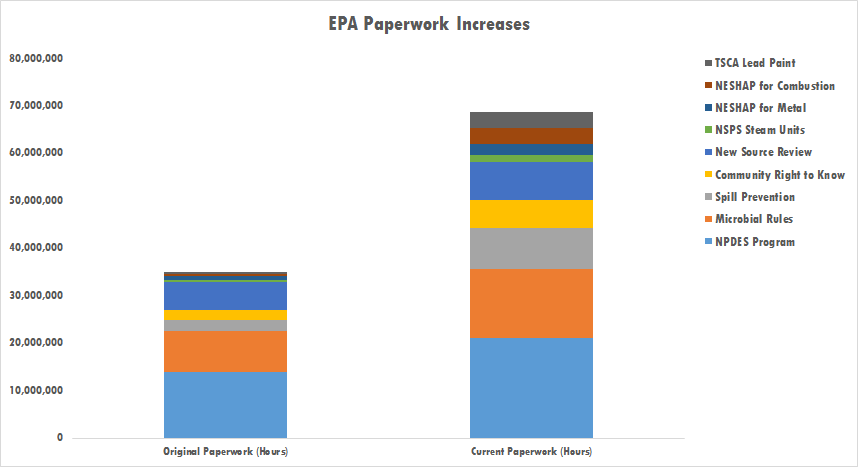Insight
June 28, 2016
EPA’s Newest Regulatory Record
As President Obama’s regulatory agenda moves into its twilight, one agency has avoided the flood of controversial rulemakings in 2016: the Environmental Protection Agency (EPA). Typically the leader in regulatory costs and benefits, EPA is just one percent of the nation’s regulatory burden this year. Aside from a final rule on fracking and oil extraction, and the agency’s costs for 2016 would be largely non-existent.
However, years of regulatory accumulation, especially under the Obama Administration have pushed EPA’s paperwork burden to its highest level in history. Year after year of new regulatory costs have not only translated into shuttered power plants, but also new reporting and recordkeeping requirements. EPA’s paperwork burden now stands at 188 million hours.
To put this in perspective, it would take more than 94,200 employees working full-time (2,000 hours a year) to complete one year of EPA paperwork. The agency’s burden has surged 23 percent since 2009 and 34 percent since 2002. See graph below.
One question is how? The agency has been busy: the Clean Power Plan, Fuel Efficiency Standards, the Ozone Rule, and Waters of the United States. However, none of these measures imposed especially large reporting and recordkeeping costs; a majority of the burdens were in the form of capital costs. The anatomy of record paperwork is a combination of lesser-known new requirements and massive upward revisions of existing paperwork collections.
Unfortunately, these records arrive in an era when President Obama pledged to “modify, streamline, expand, or repeal” existing significant regulations. Although there have been instances of streamlining and eliminating burdens, these measures are dwarfed by new regulations that add costs and paperwork.
The graph below depicts the largest changes to some of EPA’s existing paperwork slate. On net, the agency has increased these nine requirements by 33 million hours.
In addition to the existing paperwork increases above, all of which were greater than one million hours, EPA imposed three new notable requirements:
- “Citizen Science Projects:” 1 million hours
- Lead Training: 4 million hours
- Agricultural Worker Protection: 4 million hours.
Combined, these twelve new or revised requirements have added 51.5 million paperwork burden hours. It would take 25,787 employees working full-time to complete this new paperwork. To monetize the increase, assuming the average wage rate of a compliance officer ($33.26), EPA has increased its burden by $1.7 billion, more expensive than its recent Ozone rule. This accounts for more than 100 percent of EPA’s paperwork gains since 2008 and the difference is due to agency paperwork measures that expired or reduced paperwork. For example, one collection for Nonroad engines and vehicles expired on May 31, 2016, resulting in 6,000 fewer official hours. EPA can still collect this paperwork, but it would be violating the law.
In the list above, it’s strange to find “Spill Prevention, Control, and Countermeasure,” as its burden increased by 6.4 million hours. In President Obama’s 2012 State of the Union Address, he cited removing milk from this program as a major driver of regulatory savings. He joked, “With a rule like that, I guess it was worth crying over spilled milk. (Laughter and Applause.)” The rule did save $146 million, according to EPA, but it did not address paperwork. It appears, despite removing milk from the program, the agency found other ways to increase its reach.
E-Filing
One issue that should be widely accepted by everyone across the ideological divide is electronic filing: the simple ability of individuals and business to find a form online and submit it electronically. Sadly, with EPA, and with other agencies, this is rarely universal.
The EPA imposes 777 forms from 420 different macro collections of information. According to the Office of Information and Regulatory Affairs (OIRA), only 67 of those 420 macro collections can be submitted electronically. This translates to 235 forms, or 30 percent, of EPA’s regulatory portfolio that must be submitted by hand. For instance, the agency’s collection for “Fuel and Fuel Additives” cannot be submitted online, according to OIRA records, meaning 31 forms are unavailable for electronic submission.
Conclusion
In an administration that continues to collect regulatory records: most expensive year of regulation, highest number of major rules, and priciest single regulation, EPA’s paperwork plaudit only adds to the list. Although the agency is primarily known for the capital costs it imposes on industry, many of which are passed on to consumers, its paperwork burden shouldn’t be overlooked. With four major rules under review now, it’s likely 188 million hours isn’t the agency’s red tape ceiling.













